CACTUS SPINES
Translated by Yuri A. Yudin
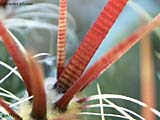 |
Photo 10 Ferocactus pilosus
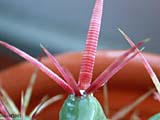 | | Photo 11 Ferocactus viridescens
| |
I. From Constellation of Cacti by Nikolay Nikonov (Sverdlovsk, Russia, 1982):
Cactus spines became proverbial. They have always been considered as a protection for the plant. But researches showed that prickly defense is secondary; the main function of spines and thorns, which are nothing else but reduced and deformed leaves or buds – areoles, is protection from sun by scattering direct light. At night they collect dew (you may have noticed that dew is usually condensed on the ends of grass blades and coniferous needles), and transport water to the stem with possibly some absorption on the way.
And finally, wool and flocks covering body of many mountain cacti protect plants from night cold. Diversity of shapes and colors is infinitely large. Gentle wooly pile, rigid beaver's hair, gray hair and long bristles, horny hooks, "steel" daggers, bayonets, sabers, hooked rosettes and crowns, feather-like spines, frosty needles, snowflakes, cobwebs, lace covers, paper scraps – from hardly noticeable to 15 cm long. Moreover, there are cacti lacking spines.
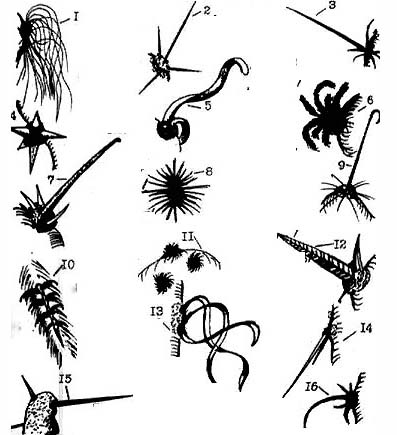
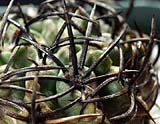 |
Photo 12 Eriosyce subgibbosa v. nigrihorrida
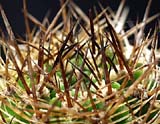 | Photo 13 Eriosyce taltalensis ssp. paucicostata
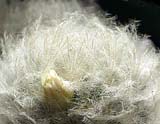 | Photo 14 Mammillaria plumosa
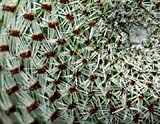 | Photo 15 Rebutia heliosa RH 291
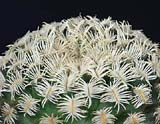 | | Photo 16 Turbinicarpus mombergii
| | | | |
Photo 1. Types of cactus spines
1. Bristled (Cephalocereus senilis)
2. Acicular (Opuntia santa-rita)
3. Subulate (Austrocylindropuntia subulata)
4. Conical (Cereus xanthocarpus)
5. Tortuous (Ferocactus acanthodes)
6. Plumose (Mammillaria plumosa)
7. Sheathed (Opuntia tunicata)
8. Pectinate (Solisia pectinata)
9. Hooked (Ferocactus wislizenii)
10. Appressed (Gymnocalycium denudatum)
11. Glochids (Opuntia microdasys)
12. Annulate (Homalocephala texensis)
13. Paper-like (Tephrocactus articulatus v. papyracanthus)
14. Deflexed
15. Porrect (Opuntia elata)
16. Down-curved
II. From http://astrophytum.narod.ru/kyltyr.html
Spines are characteristic of cacti that have leaf origin. Many scientific works have shown that spines are modified bud scales. Studies of anatomical structure and processes of spine formation have revealed that leaves and spines consist of similar tissues and spines are penetrated by vessels and have traces of chlorophyll.
Spines' shape, size and color differ very widely. They can be seta-like, needle-like, hooked, flat, ribbon-like, feather-like, hair-like, etc. Spines can be very thin or quite rough, may have circular or faceted cross-section, smooth or rugged surface, sometimes with cross grooves. Coloring is also diverse – a wide palette of white, gray, yellow, purple, red and black, of all possible shades and transitions. Sometimes there are almost colorless, translucent glassy spines. In young areoles spines are usually brighter. Spine length varies widely. Some genera have small, almost inconspicuous spines, while others' reach several tens of centimeters.
Plants in culture show large variability in spine shape and color, therefore when identifying a cactus, you should only consider arrangement of the spines in the areole.
In the upper part of areoles, Opuntia has tufts of very short, bristle, serrated spines – glochids, which are also believed to be modified leaves. Cactus spines perform numerous functions. They collect water condensate, protect stem from mechanical damage, sunburn and frost, defend from animals, facilitate in propagation of fruits and vegetative organs. Some cacti use spines to retain their weak stems on the trees.
PHOTOS:
- Photo 1. - from "Photoinformator", #7/1988, Sumy, Russia
- Photo 2–8. - from the website of Valentino Vallicelli, Italy
- Photo 10-11 - сайт www.cactusmania.ru, Alexandr Usikov, Tol'yatti
- Photo 12-16 - by Yuri A. Yudin





